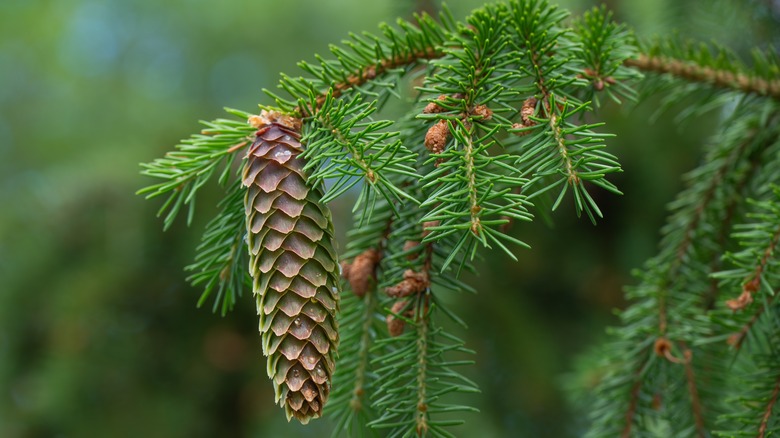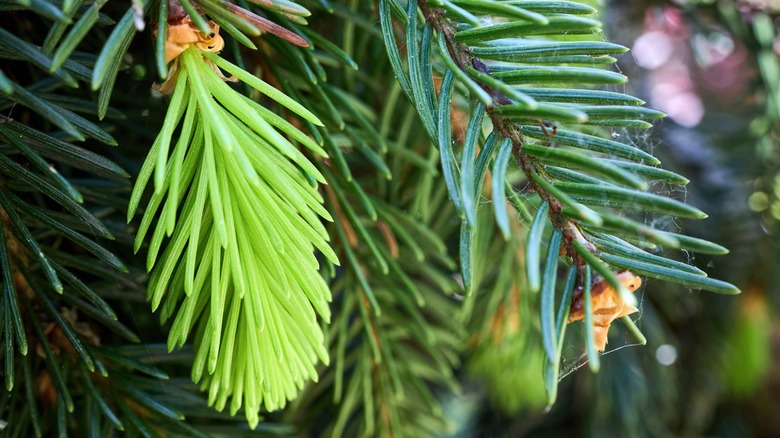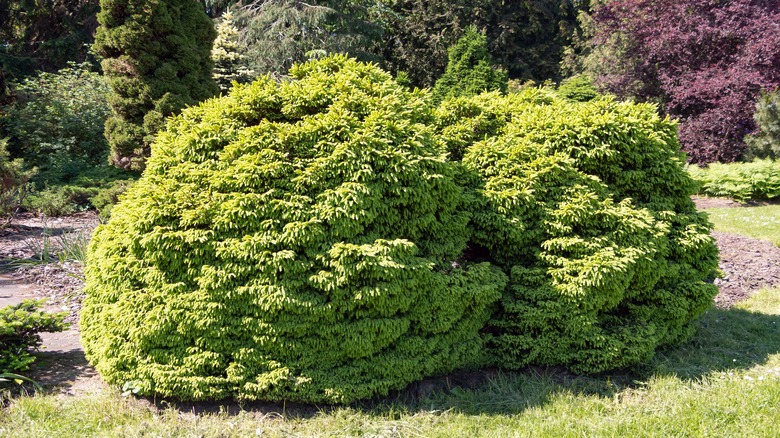The Species Of Tree That Doesn't Grow Money, But Something Similar
Trees have long been featured in folklore as symbols of good fortune, wealth, and prosperity. Of course, it is not like they are going to grow money on their branches. But what if trees can grow gold? This is exactly what a recent study published in the journal Environmental Microbiome suggests. Researchers found that the Norway spruce (Picea abies) can accumulate microscopic gold particles in its tissues, specifically the plant's needles. Dr. Lehosmaa, a researcher out of Finland, explained, "In the soil, gold is present in a soluble, liquid form. Carried by water, the gold moves into spruce needles. The tree's microbes can then precipitate this soluble gold back into solid, nanosized particles."
The idea of using plants to collect precious metals such as gold is not new, though. The process, known as phytomining, involves using certain types of plants to extract metals from the ground. It is much the same process people use to grow some plants in their gardens to enrich the soil naturally. The plants absorb nutrients from deep in the soil as they grow and then return them to the ground when they decay.
How does Norway spruce accumulate gold?
In the Norway spruce study, researchers collected 138 needle samples from 23 trees in northern Finland, near the Kittilä mine — an area known for its large underground gold deposits. Then, using high-tech imaging equipment known as FE-SEM and X-ray spectroscopy, they spotted tiny nanoscopic gold particles in the trees' needles. But how exactly did they get there? For this to happen, gold has to be present in the soil in a soluble, ionic form, allowing it to be transported by water to the roots of the plants — but the story doesn't end there. A critical role is also played by specific bacteria, known as endophytic microbes, which live inside the plant tissues.
These bacteria are similar to those that live in the roots of hairy vetch (Vicia villosa Roth), often used as a winter ground cover crop in the fall to create healthier garden soil by spring. In Norway spruce, these bacteria create biofilms within the plant tissues. There, they facilitate microenvironments that cause the soluble gold particles to be turned into nanosized solid gold precipitates. However, it is important to note here that this biomineralization process doesn't always happen. And in instances where it does, it can be sporadic and highly localized.
Should you grow Norway spruce in your garden?
Norway spruce is widely planted as an ornamental tree here in the US and is also well-known for its use as a Christmas tree. However, this is a fast-growing spruce tree variety you should avoid as it is considered invasive in parts of the country. It tends to spread and hinder the growth of other vegetation around it. But what if you still want to plant something that grows gold? Well, in that case, you can turn to growing eucalyptus, which grows well in USDA Hardiness Zones eight to 11. A study in 2013 found that eucalyptus trees also draw up gold from the soil using their root systems and then deposit it in their leaves.
However, keep in mind that planting Norway spruce or eucalyptus is not going to make you rich. The gold particles accumulated in their tissues are only a millionth of a millimeter in size. They are far too small to be collected or used for any commercial purpose. Even so, there's definite potential for bioprospecting with these trees. Researchers think they can use these plants to complement or create non-invasive and environmentally friendly exploration tools for finding gold and other precious metals and minerals, especially in sensitive ecosystems.


